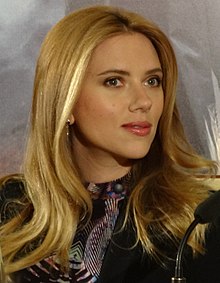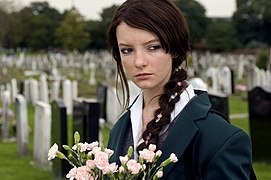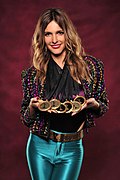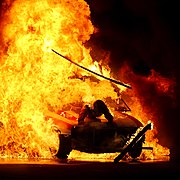Portal:Television
Portal maintenance status: (July 2018)
|
The Television Portal

Television (TV) is a telecommunication medium for transmitting moving images and sound. Additionally, the term can refer to a physical television set, rather than the medium of transmission. Television is a mass medium for advertising, entertainment, news, and sports. The medium is capable of more than "radio broadcasting", which refers to an audio signal sent to radio receivers.
Television became available in crude experimental forms in the 1920s, but only after several years of further development was the new technology marketed to consumers. After World War II, an improved form of black-and-white television broadcasting became popular in the United Kingdom and the United States, and television sets became commonplace in homes, businesses, and institutions. During the 1950s, television was the primary medium for influencing public opinion. In the mid-1960s, color broadcasting was introduced in the U.S. and most other developed countries.
In 2013, 79% of the world's households owned a television set. The replacement of earlier cathode-ray tube (CRT) screen displays with compact, energy-efficient, flat-panel alternative technologies such as LCDs (both fluorescent-backlit and LED), OLED displays, and plasma displays was a hardware revolution that began with computer monitors in the late 1990s. Most television sets sold in the 2000s were flat-panel, mainly LEDs. Major manufacturers announced the discontinuation of CRT, Digital Light Processing (DLP), plasma, and even fluorescent-backlit LCDs by the mid-2010s. LEDs are being gradually replaced by OLEDs. Also, major manufacturers have started increasingly producing smart TVs in the mid-2010s. Smart TVs with integrated Internet and Web 2.0 functions became the dominant form of television by the late 2010s. (Full article...)
Selected article - show another
Selected image - show another

| Credit: Denelson83 |
Digital television (DTV) is a telecommunication system for broadcasting and receiving moving pictures and sound by means of digital signals, in contrast to analog signals used by analog (traditional) TV. DTV uses digital modulation data, which is digitally compressed and requires decoding by a specially designed television set, or a standard receiver with a set-top box, or a PC fitted with a television card.
Did you know (auto-generated) - load new batch

- ... that Montana television station KOPR-TV brought forward its start date by several months, only to last just one year?
- ... that Japanese actor Kouhei Higuchi prepared for his role on the television drama adaptation of My Personal Weatherman by learning from a weather forecaster?
- ... that actor Jonathan Roumie, who plays the character of Jesus Christ in American television series The Chosen, is also an extraordinary minister of Holy Communion in the Catholic Church?
- ... that country music singer Waylon Jennings earned his GED by watching tapes of a Kentucky Educational Television series on his tour bus?
- ... that the WandaVision episode "Filmed Before a Live Studio Audience" employed a variety of live special effects such as wire rigs to emulate television series of the 1950s and 1960s?
- ... that Windows 3.1 had a special version, known as Modular Windows, that was controlled via television?
Selected quote - show another
| I haven't had a TV in 10 years, and I really don't miss it. 'Cause it's always so much more fun to be with people than it ever was to be with a television. And for the most part my friends can always be more entertaining than the tube ever can be. But somehow people have been sold on the idea that only professionals can entertain them, that only professionals can sing or tell jokes. And people are cut out of this creativity loop, and creativity is being limited to these large, centralized voices. |
More did you know
- ...that Richard Hanley's book South Park and Philosophy: Bigger, Longer, and More Penetrating analyzes issues of applied ethics as presented in South Park?
- ...that the 1994 Guinness television advertisement Anticipation used jump cutting techniques to make an actor appear to be performing a physically impossible dance?
- ...that the proposed BBC television special Planet Relief, created to raise awareness of climate change, was cancelled before it was made, for fear that it would be biased against climate sceptics?
- ...that the television drama Hill Street Blues imitated the visual style of The Police Tapes, a low-budget documentary about a police precinct in the South Bronx?
- ...that like the characters in his television series The Practice and Boston Legal, David E. Kelley worked as a lawyer in a Boston law firm?
Selected biography - show another
Daniel Irvin Rather Jr. (/ˈræðər/; born October 31, 1931) is an American journalist, commentator, and former national evening news anchor. He began his career in Texas, becoming a national name after his reporting saved thousands of lives during Hurricane Carla in September 1961. Rather spontaneously created the first radar weather report by overlaying a transparent map over a radar image of Hurricane Carla. In his first national broadcast, he helped initiate the successful evacuation of 350,000 people. He reported on some of the most significant events of the modern age, such as the fall of the Berlin Wall, the Gulf War, 9/11, the Iraq War, and the war on terror.
Rather also famously reported from Dallas in November 1963 at the time that President John F. Kennedy was assassinated. Based on such reporting, he was promoted at CBS News, where he served as White House correspondent beginning in 1964. He served as foreign correspondent in London and Vietnam over the next two years before returning to the White House correspondent position. He covered the presidency of Richard Nixon, including Nixon's trip to China, the Watergate scandal, and the president's resignation. (Full article...)General images
-
Image 1An early Smart TV from 2012 running the discontinued Orsay platform (from History of television)
-
Image 2Ad for the beginning of experimental television broadcasting in New York City by RCA in 1939 (from History of television)
-
Image 3Baird in 1925 with his televisor equipment and dummies "James" and "Stooky Bill" (right). (from History of television)
-
Image 4Philo Farnsworth in 1924 (from History of television)
-
Image 7LG Smart TV using the Web browser (from Smart TV)
-
Image 8Family watching TV, 1958 (from History of television)
-
Image 9First television test broadcast transmitted by the NHK Broadcasting Technology Research Institute in May 1939 (from History of television)
-
Image 10Public television in France uses 819 line b&w high definition, from 1959 until 1983 (TF1). (from History of television)
-
Image 11Comparison of image quality between ISDB-T (1080i broadcast, top) and NTSC (480i transmission, bottom) (from Digital television)
-
Image 12LG Electronics smart TV from 2011 (from Smart TV)
-
Image 13A color television test at the Mount Kaukau transmitter site, New Zealand in 1970.
A test pattern with color bars is used to calibrate the signal. (from Color television) -
Image 14Color bars used in a test pattern, sometimes used when no program material is available. (from History of television)
-
Image 15The Philco Predicta, 1958. In the collection of The Children's Museum of Indianapolis (from History of television)
-
Image 17The first mass-produced Czechoslovak TV-set Tesla 4001A (1953–57) (from History of television)
-
Image 18Samsung's discontinued Orsay platform (from Smart TV)
-
Image 19DBS satellite dishes. (from History of television)
-
Image 20RCA CT-100 at the SPARK Museum of Electrical Invention playing Superman. The RCA CT-100 was the first mass-produced color TV set. (from Color television)
-
Image 21RCA 630-TS, the first mass-produced television set, which sold in 1946–1947 (from History of television)
-
Image 22The Nipkow disk. This schematic shows the circular paths traced by the holes, which may also be square for greater precision. The area of the disk outlined in black shows the region scanned. (from History of television)
-
Image 24This live image of actress Paddy Naismith was used to demonstrate Telechrome, John Logie Baird's first all-electronic color television system, which used two projection CRTs. The two-color image would be similar to the basic Telechrome system. (from Color television)
-
Image 25Smart TVs on display (from Smart TV)
 Featured lists - load new batch
Featured lists - load new batch
-
Image 1

Millennium is an American crime-thriller television series which was broadcast between 1996 and 1999. Created by Chris Carter, the series aired on Fox for three seasons with a total of sixty-seven episodes. Millennium starred Lance Henriksen, Megan Gallagher, Klea Scott, and Brittany Tiplady. Henriksen portrayed Frank Black, an offender profiler who worked for the Millennium Group, a private investigative organisation. Black retired from the Federal Bureau of Investigation to move his wife (Gallagher) and daughter (Tiplady) to Seattle, where he began to consult on criminal cases for the Group. After his wife's death, he returned to the FBI to work with new partner Emma Hollis (Scott) to discredit the Group.
Millennium's genesis stemmed from "Irresistible", a second-season episode of The X-Files penned by Carter. Influence was also drawn from the works of Nostradamus, and the increasing popular interest in eschatology ahead of the coming millennium. The series began airing in the Friday timeslot formerly occupied by The X-Files. "Pilot", the debut episode, was heavily promoted by Fox, and brought in over a quarter of the total audience during its broadcast. (Full article...) -
Image 2

Johansson at an event for Captain America: The Winter Soldier in 2014
Scarlett Johansson is an American actress who has appeared in films, television series, video games and stage plays. Johansson made her debut in the 1994 comedy-drama North. Her first lead role was as the 11-year-old sister of a pregnant teenager in Manny & Lo (1996), for which she received a nomination for the Independent Spirit Award for Best Female Lead. Johansson starred in Robert Redford's drama The Horse Whisperer (1998), and appeared with Thora Birch and Steve Buscemi in the black comedy Ghost World (2001). Two years later, Johansson played a woman in her 20s stuck in a listless marriage who befriends an aging American actor (Bill Murray) in Japan in the Sofia Coppola-directed Lost in Translation, and also played a servant in Dutch painter Johannes Vermeer's household in Girl with a Pearl Earring with Colin Firth. She was nominated at the 61st Golden Globe Awards for both films, and received the BAFTA Award for Best Actress in a Leading Role for the former.
Two years later, Johansson starred in Woody Allen's psychological thriller Match Point, for which she garnered a nomination for the Golden Globe Award for Best Supporting Actress – Motion Picture. In 2006, she appeared in Christopher Nolan's psychological thriller The Prestige, and played a journalism student in Allen's Scoop. In the same year, Johansson made her first appearance as host of the television variety show Saturday Night Live, which she has since hosted a further five times as of 2019. Two years later, Johansson starred in Allen's romantic comedy-drama Vicky Cristina Barcelona with Javier Bardem and Penelope Cruz, and portrayed Queen of England Anne Boleyn's sister Mary in the historical drama The Other Boleyn Girl (2008) with Natalie Portman and Eric Bana. She received the Tony Award for Best Featured Actress in a Play for her Broadway debut performance in the 2010 revival of Arthur Miller's A View from the Bridge. (Full article...) -
Image 3
'"`UNIQ--templatestyles-00000017-QINU`"'
(Full article...)Image 4
The West Wing is an American political drama television series created by Aaron Sorkin and produced by John Wells Productions and Warner Bros. Television. It originally aired on NBC from September 22, 1999, to May 14, 2006, broadcasting 156 episodes over seven seasons. A special episode was also released on October 15, 2020, on HBO Max.
The show follows the lives of White House staffers during the fictional Democratic presidential administration of Josiah Bartlet. The show originally starred Rob Lowe as Sam Seaborn, Moira Kelly as Mandy Hampton, Allison Janney as C. J. Cregg, Richard Schiff as Toby Ziegler, John Spencer as Leo McGarry, Bradley Whitford as Josh Lyman, and Martin Sheen as Bartlet. Over the course of the show's run, the main cast added Dulé Hill as Charlie Young, Janel Moloney as Donna Moss, Stockard Channing as Abbey Bartlet, Joshua Malina as Will Bailey, Mary McCormack as Kate Harper, Jimmy Smits as Matt Santos, Alan Alda as Arnold Vinick, and Kristin Chenoweth as Annabeth Schott. (Full article...)Image 5Baccano! is a 2007 anime series directed by Takahiro Omori and produced by Brain's Base and Aniplex. The 16 episodes are adapted from the light novels of the same name written by Ryohgo Narita and illustrated by Katsumi Enami. Told in out-of-order sequences, the story spans three consecutive years of Prohibition-era America during which three seemingly unconnected events occur: two bottles of immortality elixir are passed around Manhattan by gangsters believing it is alcohol, a supposed monster massacres members of two gangs attempting to hijack the transcontinental train Flying Pussyfoot, and a missing man is tracked down by his sister and a gang. The first thirteen episodes aired in Japan from July 26, 2007, to November 1, 2007, on WOWOW, a Japanese pay-per-view station, and the final three were released direct-to-DVD. The series made its North American television debut when it started airing on the Funimation Channel after the channel transitioned to HD in September 2010.
Eight DVD compilations were released by Aniplex, each containing two episodes, with the first released on October 24, 2007, and the eighth on May 28, 2008. A Blu-ray boxset was released January 26, 2011. On July 21, 2008, the English adaptation of Baccano! was licensed by Funimation. They released four DVD compilations, each containing four episodes, with the first released on January 27, 2009, and the fourth on June 16, 2009. A complete DVD collection boxset was released December 29, 2009, and re-released on December 28, 2010, as part of a lower-priced Viridian Collection. A limited edition Blu-ray boxset was released May 17, 2011; the Blu-ray set was later rereleased on July 31, 2012. The entire English-dubbed series was streamed through Hulu during October 2009 and English-subtitled episodes although once available for streaming, have been removed as of December 2017. Funimation streams English-subtitled and English-dubbed episodes through their website. In Australia and New Zealand, the series is licensed by Madman Entertainment, who released the series over four DVDs between June 24, 2009, and October 21, 2009. A boxset was released on March 17, 2010. Baccano! is licensed in the United Kingdom by Manga Entertainment and was released in a complete boxset on October 11, 2010. The series is aired in the Philippines, Hong Kong and Southeast Asia on Animax Asia. (Full article...)Image 6What Would You Do? (commonly abbreviated as WWYD, and formerly known as Primetime: What Would You Do? through the program's fifth season) is an American situational hidden camera television series that has been broadcast on the American Broadcasting Company (ABC) since February 26, 2008. Created by Chris Whipple, the show with a social experiment format follows the reactions of passing strangers as they encounter conflict or illegal activity in a public setting, unaware that it is all staged and being recorded with hidden cameras. Throughout all of its seventeen seasons, the show has been hosted by news correspondent John Quiñones.
Appearing periodically on ABC's Primetime from 2005 to 2007, What Would You Do? became an instant success for the ABC network. Following the 2007 writers' strike, ABC ordered the first season of the show. The series was annually renewed for a second, third, fourth, and fifth season. Starting with the sixth season, the show began to feature guest appearances, which included Barbara Corcoran, Howie Mandel, and Meredith Vieira. Following the seventh season, What Would You Do? aired its first Christmas special in its eighth season. This was followed by guest appearances by Daymond John and Pnina Tornai in the show's ninth season, Winnie Harlow in the show's tenth season, and an era without guests in the show's eleventh and twelfth seasons. A 10-year anniversary special was aired in 2017 as the season finale of the thirteenth season, titled "What Would You Do?: Then and Now", featuring scenarios originally aired on Primetime and in season one being remade with the same actors in the same locations. Following the fourteenth and fifteenth seasons of the show, ABC announced that they would air episodes filmed before the COVID-19 pandemic as part of the show's sixteenth season, as well as a special hosted by Gio Benitez as part of the sixteenth season's season finale. In May 2023, ABC renewed the series for a seventeenth season after a three-year hiatus. (Full article...)Image 7
The Office is an American television sitcom broadcast on NBC. Created as an adaptation by Greg Daniels of the British series of the same name, it is a mockumentary that follows the day-to-day lives of the employees of the Scranton, Pennsylvania branch of Dunder Mifflin, a fictional paper supply company. The series ran on NBC in the United States from March 24, 2005, to May 16, 2013. Additionally, nine spin-off series of webisodes of The Office have been aired on NBC.com.
The Office aired a short first season in 2005 that consisted of six episodes. This was followed by a full-length second season in 2005–06 that consisted of 22 episodes, and a third season in 2006–07, with 25 episodes. Due to the 2007–2008 Writers Guild of America strike, the fourth season that aired in 2007–08 consisted of 19 episodes. The fifth season aired during 2008–09 and consisted of 28 episodes. The sixth season aired during 2009–10 and consisted of 26 episodes. The seventh season aired during 2010–11 and consisted of 26 episodes. The eighth season aired during 2011–12 and consisted of 24 episodes. The ninth season aired during 2012–13 and consisted of 25 episodes. A total of 201 episodes of The Office aired over nine seasons. (Full article...)Image 8
Katy Perry at the premiere of Katy Perry: Part of Me in June 2012
American singer Katy Perry has released two video albums and has appeared in various music videos, films, television shows, and television commercials. After appearing in several music videos between 2004 and 2007, including "Goodbye for Now" and "Cupid's Chokehold", a video for "Ur So Gay" was released to introduce her to the music industry. In 2008, she released videos for "I Kissed a Girl" and "Hot n Cold", both taken from her second album One of the Boys. Videos for "Thinking of You" and "Waking Up in Vegas" were released the following year.
Perry's third album Teenage Dream (2010) spawned the single "California Gurls", whose music video is set in the fictional land of "Candyfornia" and features rapper Snoop Dogg. The Yoann Lemoine-directed video "Teenage Dream" depicts her as a euphoric teenager. Her "Firework" video is based on self-empowerment, and won the MTV Video Music Award for Video of the Year. The video for "E.T." takes place in outer space, and features rapper Kanye West. Perry also released "Last Friday Night (T.G.I.F.)"—a video based on a hangover after a house party—and "The One That Got Away"—which focuses on flashbacks of days with a deceased lover. In 2012, she reissued her third album as Teenage Dream: The Complete Confection, and also released videos for the singles "Part of Me" and "Wide Awake". The following year, Perry released her fourth studio album Prism, with "Roar" as its lead single, whose music video features her in a jungle after a plane crash. The video for her next single, "Unconditionally", is based on unconditional love. In the "Birthday" video, she impersonates five different characters to entertain at birthday parties. She became the first artist to have multiple videos, "Dark Horse" and "Roar", each gain one billion views on Vevo. Perry's fifth album Witness spawned music videos for the songs "Chained to the Rhythm", "Bon Appétit", "Swish Swish", and "Hey Hey Hey". She has 23 vevo certified videos, including for Roar, Last Friday Night, E.T., Never Really Over and Wide Awake. 2 videos have over 3 billion views and a further 3 have over a billion views. (Full article...)Image 9Gielgud in 1936
Sir John Gielgud, OM, CH (/ˈɡiːlɡʊd/; 1904–2000) was an English actor and theatre director. He appeared on stage, television and radio and in film in a career that spanned eight decades. Film historian Brian McFarlane, writing for the British Film Institute, wrote of Gielgud that "in terms of the performing arts, it is no exaggeration to say that he towered over the century".
Gielgud, a member of the theatrical dynasty the Terry family, began working on stage in 1921 before attending the Royal Academy of Dramatic Art. After completing his studies he worked in repertory theatre and in the West End before establishing himself at the Old Vic in the 1930s. He continued working on the stage until 1990 both as a director and actor. Although he made some films early in his career, he did not start working regularly in the medium until he was in his sixties; in the course of just over thirty years between 1964 and 1998 he appeared in over sixty films. He was active on television and radio, appearing in numerous plays and interviews, and was also in demand as a narrator. (Full article...)Image 10Tsukihime, Lunar Legend (真月譚 月姫, Shingetsutan Tsukihime) is an anime television series. The episodes are directed by Katsushi Sakurabi, animated by J.C.Staff, and produced by the Tsukihime Production Committee, which included Geneon Entertainment, Movic, Tokyo Broadcasting System, and J.C.Staff. The English adaptation of the episodes has been licensed by Geneon Entertainment. The episodes are based on the visual novel Tsukihime by Type-Moon and adapt the source material over twelve episodes. The plot of the episodes follows Shiki Tohno after he moves into his sister's house, and his interactions with the vampire Arcueid Brunestud.
The episodes aired in Japan from October 10, 2003 to December 26, 2003 on BS-i. The episodes received their international premiere on the anime television network Animax, who have also later broadcast the series across its respective networks worldwide in Southeast Asia and South Asia, and its other networks in East Asia, South America and other regions under the title Lunar Legend Tsukihime. (Full article...)Image 11The Golden Martín Fierro Award is presented annually by the Asociación de Periodistas de la Televisión y Radiofonía Argentina (APTRA) (Spanish: Association of journalists of Argentine television and radio). It is given to honor an Argentine individual with an outstanding career in the media of Argentina or a recent production of outstanding quality. APTRA described the standard as "the best among the best". It was first awarded in 1992 at the Martín Fierro Awards ceremony for works from 1991. It is a special award, unrelated to the regular ones, which are distributed in categories. A second award, the Platinum Martín Fierro Award, is selected by public poll among the previous recipients of the Golden award. This second award was created in 2009 for works from 2008, but there was no Platinum award for the 2013 ceremony. The awards for the cable television were split to their own ceremony, with its own Golden Martín Fierro in 2015.
The talk show Fax was the first recipient of the award, and, as of 2018, 100 días para enamorarse is the most recent. No recipient has received the award twice, but Nicolás Repetto, host of Fax, received a personal one in 2000. Facundo Arana, Julio Chávez, Mercedes Morán, Celeste Cid, Carla Peterson, Nancy Dupláa, Pablo Echarri, Diego Peretti and Gabriela Toscano have been lead actors of different works of fiction that received the award. (Full article...)Image 12Hattie Jacques (/dʒeɪks/; born Josephine Edwina Jaques; 1922–1980) was an English actress who appeared in many genres of light entertainment including radio, film, television and stage. Jacques's career spanned from 1939 until her death in 1980. She is best remembered for her appearances in fourteen Carry On films and for her professional partnership with Eric Sykes.
In 1939 Jacques became involved in amateur dramatics, appearing as Doris Gow in Noël Coward's short play Fumed Oak. Five years later, after wartime service as a nurse and a welder, she made her professional theatrical debut at the Players' Theatre in the revue Late Joys, a performance that she repeated on television in 1946. From there she became a regular stage performer, appearing in variety shows and Victorian-style pantomimes. (Full article...)Image 13
Breaking Bad is an American television crime drama series created by Vince Gilligan that premiered on AMC on January 20, 2008. Set in Albuquerque, New Mexico, the show follows the life of Walter White (Bryan Cranston), a high school chemistry teacher struggling with stage-three lung cancer who decides to produce and distribute crystal meth with his former student Jesse Pinkman (Aaron Paul) to secure his family's financial future. Concurrently, his wife Skyler (Anna Gunn) grows suspicious and his brother-in-law and DEA agent Hank Schrader (Dean Norris) begins to investigate. After five seasons and a total of 62 episodes, the series concluded on September 29, 2013.
Upon its release, Breaking Bad became one of the highest-rated shows on network television and received universal acclaim, with particular praise for its acting, characters, writing, direction, and cinematography; it entered the Guinness World Records in 2014 as the most critically acclaimed show of all time. Its impact on television resulted in the creation of the spin-off series Better Call Saul, centered on the character of Saul Goodman (Bob Odenkirk), and a sequel released in 2019 as El Camino: A Breaking Bad Movie, both of which also received positive reviews. (Full article...)News
Wikinews television portal- December 28: US professional wrestler Jon Huber dies aged 41
- September 2: Tributes paid to recently deceased US actor Chadwick Boseman
- May 24: Japanese professional wrestler and Netflix star Hana Kimura dies aged 22
- January 16: BBC newsreader Alagiah to undergo treatment for bowel cancer
- Upcoming events
Featured content
No.
overallNo. in
seasonTitle Directed by Written by Original air date Prod.
codeU.S. viewers
(millions)1 1 "Simpsons Roasting on an Open Fire" David Silverman Mimi Pond December 17, 1989 (1989-12-17) 7G08 26.7 2 2 "Bart the Genius" David Silverman Jon Vitti January 14, 1990 (1990-01-14) 7G02 24.5 3 3 "Homer's Odyssey" Wes Archer Jay Kogen & Wallace Wolodarsky January 21, 1990 (1990-01-21) 7G03 27.5 4 4 "There's No Disgrace Like Home" Gregg Vanzo & Kent Butterworth Al Jean & Mike Reiss January 28, 1990 (1990-01-28) 7G04 20.2 5 5 "Bart the General" David Silverman John Swartzwelder February 4, 1990 (1990-02-04) 7G05 27.1 6 6 "Moaning Lisa" Wes Archer Al Jean & Mike Reiss February 11, 1990 (1990-02-11) 7G06 27.4 7 7 "The Call of the Simpsons" Wes Archer John Swartzwelder February 18, 1990 (1990-02-18) 7G09 27.6 8 8 "The Telltale Head" Rich Moore Al Jean, Mike Reiss, Sam Simon & Matt Groening February 25, 1990 (1990-02-25) 7G07 28.0 9 9 "Life on the Fast Lane" David Silverman John Swartzwelder March 18, 1990 (1990-03-18) 7G11 33.5 10 10 "Homer's Night Out" Rich Moore Jon Vitti March 25, 1990 (1990-03-25) 7G10 30.3 11 11 "The Crepes of Wrath" Wes Archer & Milton Gray George Meyer, Sam Simon, John Swartzwelder & Jon Vitti April 15, 1990 (1990-04-15) 7G13 31.2 12 12 "Krusty Gets Busted" Brad Bird Jay Kogen & Wallace Wolodarsky April 29, 1990 (1990-04-29) 7G12 30.4 13 13 "Some Enchanted Evening" David Silverman & Kent Butterworth Matt Groening & Sam Simon May 13, 1990 (1990-05-13) 7G01 27.1 Main topics
History of television: Early television stations • Geographical usage of television • Golden Age of Television • List of experimental television stations • List of years in television • Mechanical television • Social aspects of television • Television systems before 1940 • Timeline of the introduction of television in countries • Timeline of the introduction of color television in countries
Inventors and pioneers: John Logie Baird • Alan Blumlein • Walter Bruch • Alan Archibald Campbell-Swinton • Allen B. DuMont • Philo Taylor Farnsworth • Charles Francis Jenkins • Boris Grabovsky • Paul Gottlieb Nipkow • Constantin Perskyi • Boris Rosing • David Sarnoff • Kálmán Tihanyi • Vladimir Zworykin
Technology: Comparison of display technology • Digital television • Liquid crystal display television • Large-screen television technology • Technology of television
Terms: Broadcast television systems • Composite monitor • HDTV • Liquid crystal display television • PAL • Picture-in-picture • Pay-per-view • Plasma display • NICAM • NTSC • SECAM
Categories
WikiProjects

You are invited to participate in WikiProject Television, a WikiProject dedicated to developing and improving articles about Television.
- Main projects
- Sub-projects
Television Stations • American animation • American television • Australian television • British TV • BBC • Canadian TV shows • Television Game Shows • ITC Entertainment Productions • Digimon • Buffyverse • Doctor Who • Degrassi • EastEnders • Episode coverage • Firefly • Futurama • Grey's Anatomy • Indian television • Lost • Nickelodeon • The O.C. • Professional Wrestling • Reality TV • The Simpsons • Seinfeld • South Park • Stargate • Star Trek • Star Wars • Soap operas • Avatar: The Last Airbender • House
- Related projects
Animation • Anime and manga • Comedy • Comics • Fictional characters • Film • Media franchises
What are WikiProjects?
Things you can do

Things you can do - Place the {{WikiProject Television}} project banner on the talk pages of all articles within the scope of the project.
- Write: Possible Possum
- Cleanup: color television, Alien Nation: Body and Soul, The Sopranos, Alien Nation: Dark Horizon, Alien Nation: The Enemy Within, Alien Nation: Millennium, Aang
- Expand: Timeline of the introduction of color television in countries
- Stubs: Flow (television), Just for Kicks (TV series), Play of the Month, Nova (Dutch TV series), More stubs...
Subportals
Related portals
Associated Wikimedia
The following Wikimedia Foundation sister projects provide more on this subject:
-
Commons
Free media repository -
Wikibooks
Free textbooks and manuals -
Wikidata
Free knowledge base -
Wikinews
Free-content news -
Wikiquote
Collection of quotations -
Wikisource
Free-content library -
Wikiversity
Free learning tools -
Wiktionary
Dictionary and thesaurus
Discover Wikipedia using portals
- Portals with triaged subpages from July 2018
- All portals with triaged subpages
- Portals with no named maintainer
- Random portal component with over 50 available subpages
- Random portal component with 21–25 available image subpages
- Random portal component with 31–40 available subpages
- Automated article-slideshow portals with 201–500 articles in article list



































































